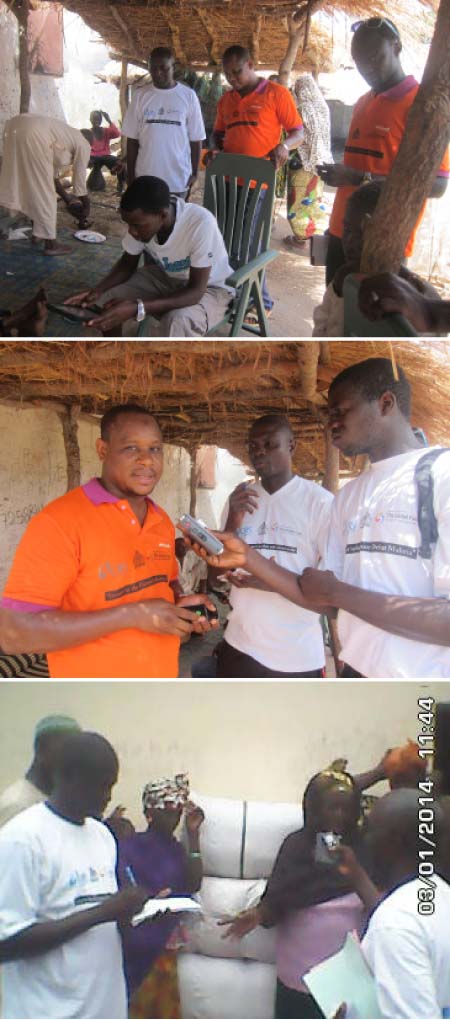
Speaking to journalists in an interview, Saiku Janneh, CRS behaviour change communication manager, said the bed net distribution exercise is done two-fold - routine distribution through RCH clinics, and mass distribution through nationwide campaigns - every three years.
According to him, universal access to LLINs is a key component of a comprehensive strategy called integrated vector management strategy, adding that the initial process of the campaign was the registration of members of each household.
This electronic form of registration was the first of its kind in The Gambia as data are collected through specially designed iPad, he said.
During registration, vouchers are issued to every member of a household and to any odd member left, after dividing the total number of resident household members by 2, he stated.
“Pregnant women and children under the age of one year will also be given vouchers if they have not already been given a net at health facility level, “added Mr Janneh.
He said new nets must be aired for 24 hours before they are used, adding that such airing should be done under a shade because direct exposure of nets to sunlight “compromises” the efficacy of the insecticide.
Failure to air a new net for 24 hours could induce reactions to some people, he said, adding that although “the severity is usually mild”, the discomfort could deter some people from sleeping under it.
Burning sensation on the face and skin rashes have been reported among people who slept under a treated net, without initially airing it for 24 hours, he disclosed.
The net should never be washed with soda, bleach or other strong detergents, he said, adding: “Ordinary soap usually referred to as Sankung Sillah soap is adequate.”
Baba Balajo, programme manager at CRS, said the overarching goal of the project was to reduce malaria-related morbidity and mortality of the entire population in five health regions to reach pre-elimination stage by March 2015.
According to him, the programme had four objectives, which are to increase the proportion of confirmed malaria cases and provide the most efficacious treatment in the targeted five health regions among the population at risk from 27% to 80% by 2015; to contribute to the rapid scale-up of the use of insecticide treated mosquito nets to the entire population by 2015; to protect all populations in the three health regions (LRR, CRR and URR) from malaria through Indoor Residual Spraying of 80% of households by 2015; and to increase to 80% the proportion of the population in five health regions who take appropriate action to prevent and treat malaria (2 doses of IPTp, consistently sleep under a treated mosquito net, timely health seeking, and acceptance of IRS) through Behavioural Change Communication (BCC) by 2015.
The objective of the ITN component, Mr Balajo added, was to contribute to the rapid scale-up to universal coverage of the population at risk of malaria in 2012, through 100% coverage, sustaining this through 2015 and the Behaviour Change Communication (BCC) component.
This objective will be achieved through routine distribution of LLINs in health facilities across the country, thus complemented by mass LLIN distribution campaign targeting the general population, he said.
Catholic Relief Services (CRS) was responsible for the distribution and promotion of the use of Insecticide Treated Nets, as well as the BCC components of the malaria grant, he noted.
According to him, LLIN distribution is in phases: in round 9 phase one (2010 to 2012) 1,290,688 LLINs were distributed countrywide and round 9 phase two (2013) 207,142 LLINs were distributed countrywide.
In Phase two of the project (January 2013 to December 2015), approximately 329,497 LLINs will be distributed to pregnant women and children under one year on routine basis through RCH clinics;
1,000,000 LLINs will be distributed through a mass LLIN campaign between May and June of 2014 through routine distribution through RCH clinics.
It would be done under trained volunteers targeting children under one year and pregnant women and the general population across the country, he said.
Community outreach activities for Behaviour Change Communication (BCC) are conducted through trained volunteers called Kabilo Representatives (KRs), Positive Deviant Individuals (PDIs) and Peer Health Educators (PHEs) in and out of school, he stated.
Alieu Bah, team supervisor stated that upon completion of registration, nets would be given to those who present their vouchers to the distributors and such vouchers would be marked with indelible ink, so they could not be presented to another distributor for a net and “this process takes place in public places, such as bantabas”.
By the end of the campaign over one million long-lasting insecticide treated nets would be distributed across the country between May and June 2014, he said.
The campaign is in phases: phase 1 URR, 2 CRR, 3 LRR and NBR, and 4 WCR, KMC and BCC.
He said correct and consistent use of LLINs net is the only way to defeat malaria, adding that every household was targeted across the community for the fact that the population of the country is close to two million and the campaign is two to a net.
According to him, every two years they conduct behaviour change communication surveys looking at primary areas including the usage of LLINs and over the years they had got indicators from all the surveys that had been conducted by CRS and its partners that the intervention had greatly impacted in the lives of beneficiaries, showing that malaria had drastically reduced but they don’t need to be complacent; rather they need to redouble their efforts to ensure the primary objective is achieved - reaching pre-elimination stage of malaria by 2015.
“Right now we are on track to achieve this objective, “he said, adding that in most communities they have kabilos, representatives and positive defending individuals who visit households and promote the use of bed net, IRS and early treatment behaviour if someone catches fever.
Read Other Articles In Article (Archive)

Super Nawettan Committee awards Brikama with trophy, cash prize
Dec 31, 2012, 9:04 AM
Judgment entered in favour of plaintiff
May 13, 2011, 2:43 PM


